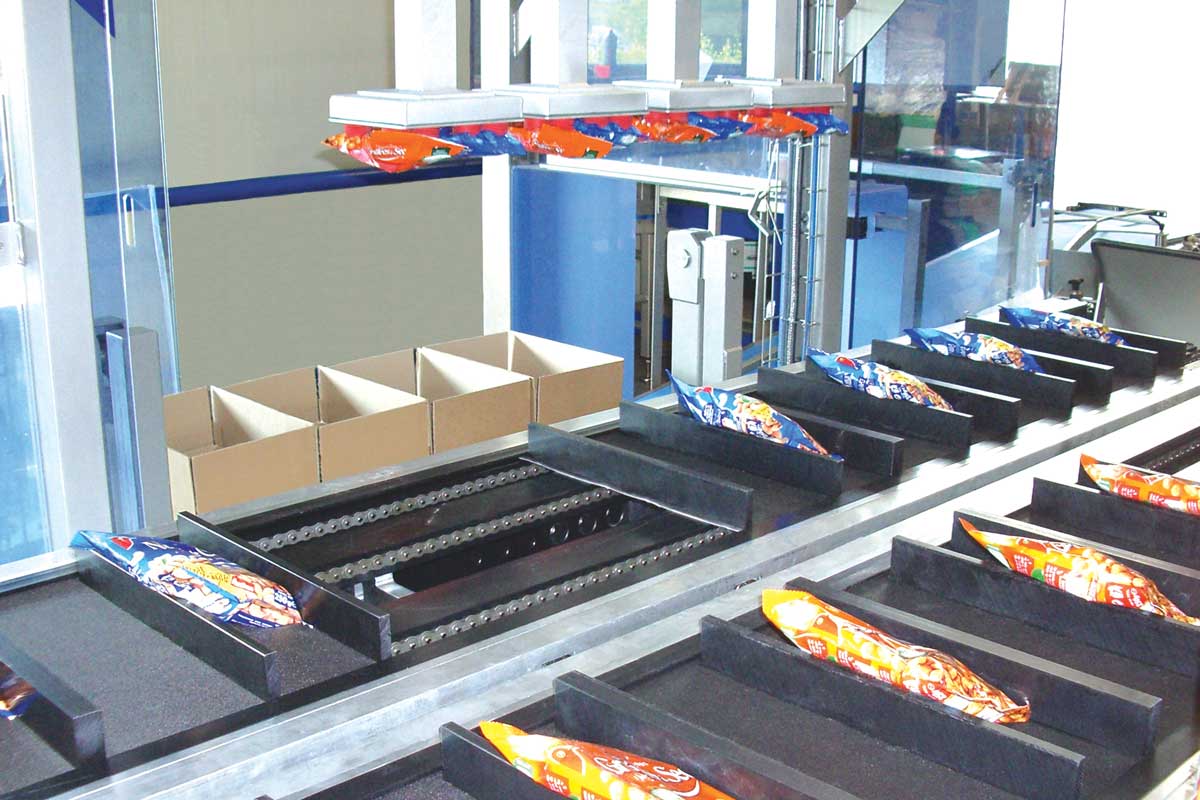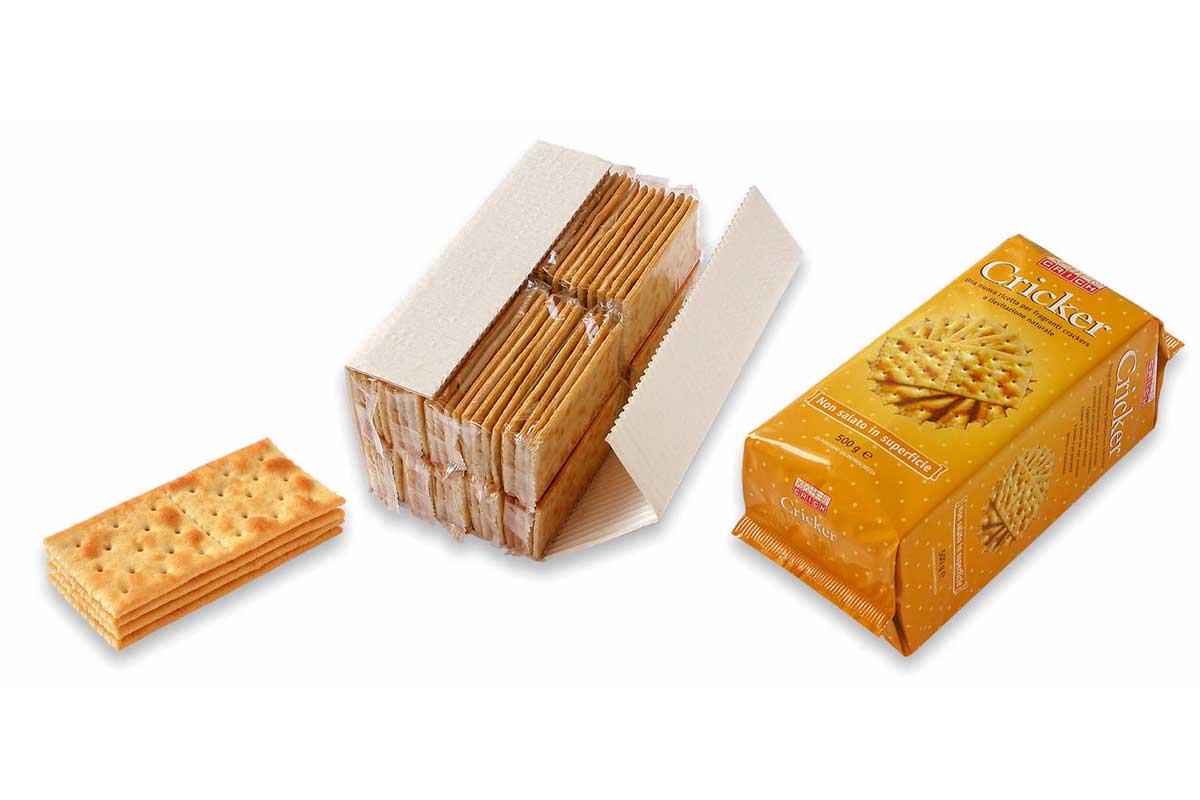Maybe it was the simple 12-count of colored pencils, or perhaps it was the advanced 64-count of crayons. Everyone — whether child or parent — had the elementary school challenge: returning the art tools orderly and snugly in their box without damaging some or leaving others behind. The difficulty only increases as the box count increases. And what’s more, all of this takes time.
Baking and snack manufacturers have similar difficulties when putting together multipacks. What looks like a simple process of bundling individually packaged products into a large container is more complicated. It can vary depending on what’s being packed and whether it has the strength of a bar, the shape of a snack cake or quantity of a cracker. If not managed properly, the reality looks more like trying to jam those crayons into the same box — and sometimes the wrong box.
Less packaging, less cost
Why produce multipacks in the first place? Bill Kehrli, vice-president, sales and marketing, Cavanna Packaging, shared some background on the packaging format.
“The purpose of a folding carton was twofold,” he said. “The reason multipacks started 120 years ago was because it provided shipping integrity and a nice billboard to present advertising to the consumer walking through the grocery store. Now, times have changed, though the original reasons can apply. Some consumers demand bulk items, and manufacturers can consolidate products to increase space and reduce cost, particularly in shipping.
Multipacks can have different packaging configurations and shipping needs. Unlike crayons, baked foods can be soft and delicate. For this reason, multipacks in this sector are usually two-material packaging so that one can provide support.
“Baked goods don’t always have a lot of structure for stacking or putting multiple pieces in a package, so you need to put some kind of a tray with it or box,” said Dennis Gunnell, president, Formost Fuji.
This protection comes in the form of corrugated paper such as a carton, chip or sleeve.

“Generally, paper for snack cakes and bread provides more shipping integrity than other types of multipacks,” Mr. Kehrli said.
U-boards and c-boards, or flat cardstock with bottom and side walls, are placed under flexible products — and even stable ones — to keep the single packages together and provide greater strength.
Snacks are more stable and require fewer packaging layers. Granola bars are thick and easily stacked. Mr. Kehrli said crackers should also be targeted for multipacks because, despite their seemingly fragile composition, the edges are strong. This strength increases when tightly flowwrapped together, stacked and placed on their side.
The most common secondary packaging for multipacks is regular slotted cases (RSC), said Guilherme Vivona, director of South American operations, BluePrint Automation (BPA).
“In South America, most of those cases are nicknamed ‘boomerang,’ as they can be used several times,” he said. “In the U.S., they are referred to as reusable cases.”
Some single-wrapped snacks have enough stability with just a standard flowwrapper. This is common in Europe and Latin America, where manufacturers are eliminating cartons.
“They seem to have a lot more multipacks than we do,” Mr. Gunnell said. “For a stack of crackers, they typically would not put those in a carrier tray. With a 12-pack, for example, they try and reduce the cost by just overwrapping it in another layer of material.”
In the United States, products are put in a primary flowwrap, then a carton and a case, which are palletized and shipped. Despite the innovation of carton and case removal, U.S. producers haven’t been able to part with them. Mr. Kehrli has seen some flowwrapped multipacks in the United States made by international companies that have reduced packaging. This allows them to sell multipacks in dollar stores, which have such a low price point that the packaging cost can easily outweigh product cost.
E-commerce is driving innovation in multipack materials.
“I see change coming for packaging,” Mr. Kehrli said. “As we get away from the grocery store and do more business with e-commerce, shipping has to be done in a different way. We don’t need cartons. Multipack with flowwrap saves space, includes more product and is more efficient, driving costs down.”
With e-commerce, consumers are offered customization with multipacks such as choosing the quantity, sizes and flavors.
“Producers must be prepared to accommodate these orders while maintaining efficiency and cost,” Mr. Vivona said. “This can be a challenge and where a versatile packing solution comes into play.”
Machines for the masses
In addition to packaging issues, putting products into multipacks comes with other challenges. Equipment offers solutions, but with multipacks, there might be some give-and-take.
Baked foods can be soft and delicate. For this reason, multipacks in this sector are usually two-material packaging so that one can provide support.
“First, you will want a very efficient indexing system that will correctly count each product and align them perfectly to be packed,” Mr. Vivona stated. “Second, note that in a multipack system all lines are dependent of each other. If one bagger fails to send its products, the system must shut down until the failed line comes back up, reducing plant efficiency.”
Higher speeds and efficiency are always common requests.
“Producers have typically relied on manual labor to hand pack their multipacks,” Mr. Vivona said. “Now producers are looking for reliable technologies that can replace those people for a safer, more cost-efficient and productive result.”
BPA uses vision-guided robotics to pick and place items onto an infeed line, wrapper chain or directly into the secondary container.
“It is quite common for a single secondary packaging machine to be fed from more than one bagger,” Mr. Vivona noted. “With multipacks, this is not the case. Complexity increases when it comes to different s.k.u.s being packed on a single, secondary packaging system.”
Although many food manufacturers want one line to run all different packages for efficiency, this can also create a storage issue. Where will the single-wrapped items be kept until the machine changeover for multipacking? Mr. Gunnell said companies will dump the product in totes. Others have more sophisticated methods such as a buffer system, organized and stacked product, or a line with multiple machines that can run everything at once.
He encouraged them to evaluate whether a dedicated machine for multipacks makes the most sense. If the volume isn’t there, it might be difficult to get the necessary return on investment. However, multipack equipment could be the best solution if all facets have been considered.
“Customers all want flexibility, easy changeover and low cost,” Mr. Gunnell said. “The three are challenging to put together because there’s the complexity of how to manage multiple products on the same machine.”
Defining the perimeters
It would be frustrating to finally fit colored pencils neatly into their 72-count box only to watch the child dump them onto the floor then ask for crayons. All that time and effort would be rendered unnecessary.
Not all retailers like multipacks or believe they’re better, Mr. Vivona noted. Sometimes a multipack will contain a flavor that’s not in demand, increasing the retailer’s inventory and affecting sales. Initial research is crucial.

“Be sure there is a demand for the multipack that it is satisfying a need with consumers,” Mr. Vivona said. “It may increase production cost and could impact overall efficiency of the plant. Select a partner that is willing to understand your needs and provide you with the correct multipack solution.”
What should the multipack look like? What count and orientation will it be in? What packaging material is best? These questions — and more — must be answered as early as possible. And often, the more flexible a company decides to be, the more efficient the process.
It all begins with getting the entire team together — sales, marketing, film suppliers, tray suppliers — to decide how the company will achieve set goals.
“Too often, after they determine this is what they want and things are further down the line, companies realize they’ve made all those decisions in a vacuum,” Mr. Gunnell said. “Then they say, ‘How are we going to do this?’ If everyone is on the same page and talking through it before, there will be effective solutions.”
Pack Expo 2019, held Sept. 23-25 in Las Vegas, provides another space for companies to discuss multipack solutions. With approximately 2,000 exhibitors, the exhibit hall will be filled with equipment from case erecting and tray forming to filling and closing machines.
Prepare by understanding the consumer and retail demand, the product’s packaging needs, and the give and take of multipack equipment. A proper plan for multipacks can make the act of placing items in a bigger container simpler than fitting crayons into their box.




